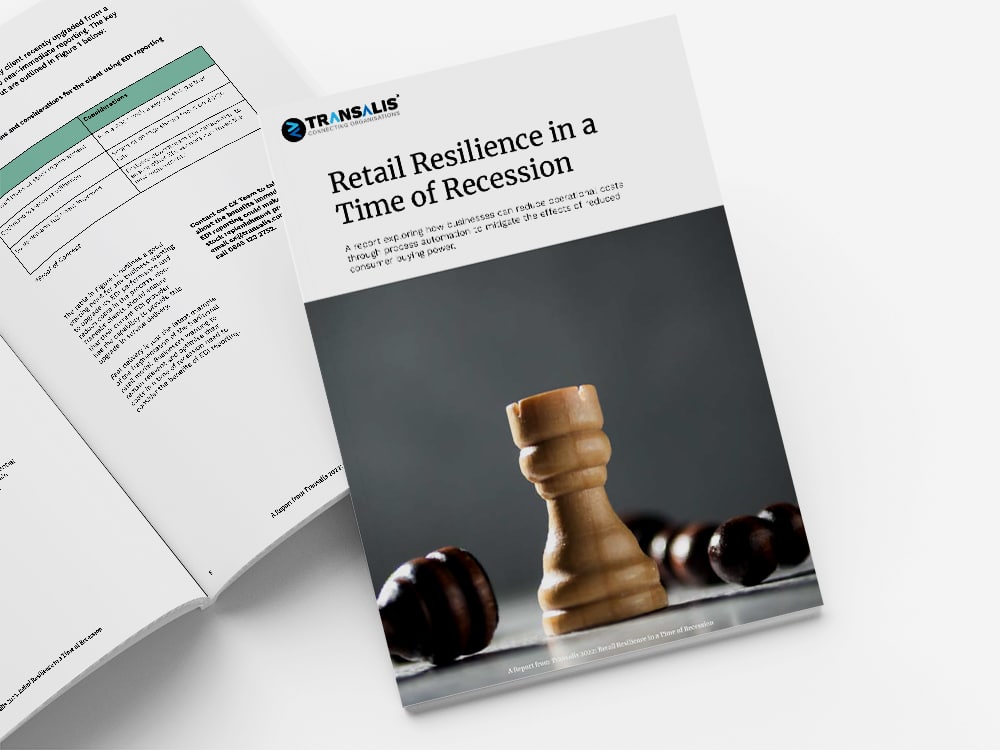
An overnight batch stock replenishment process cannot meet the consumer demand for better value and convenience.
But what other options do retailers have to optimise stock replenishment?
Retailers made significant changes to their business model to capitalise on changing consumer behaviours during the pandemic and beyond. However, following the fire-fighting of recent years, retailers need to consider the longevity of their plans and how they can future-proof business. Particularly in the case of the stock replenishment process. Retailers are still heavily reliant on an overnight batch approach. This is not efficient nor sustainable in today’s retail conditions.
In this blog, we explore why retailers need to adopt digital transformation strategies in line with new consumer demands.
Retail Resilience in a Time of Recession
Help build a resilient future for your business by implementing the recommended strategies included in the latest report from Transalis.

What are the main challenges facing the retail industry today?
Retailers have had to adapt and pivot their business strategy to meet the rapidly changing retail landscape in recent years. Unsurprisingly, the COVID-19 pandemic and Brexit had a significant impact retail business operations. Increasing consumer demand for online retail channels has dramatically influenced business strategy and decision-making in recent years. This has resulted in the widespread adoption of Direct to Consumer (D2C), investment in supply chain agility and the introduction of tactical stock allocation. All of these now represent retail best practices.
However, the Bank of England forecasts further challenges for retail businesses as a looming recession sits on the horizon.* Therefore, consumer buying power is diminishing, and inflation continues to climb to levels not seen for three decades. Retailers need to tread carefully. Costs are rising for all, not just consumers. Product and labour shortages as well as energy price increases have impacted supplying, manufacturing and shipping of consumer goods. Reducing operational costs is critical for retailers to experience continued success into the future.
Insightful retailers are already implementing business changes that address the mid-term impact of a recession. Other retail businesses need to do the same or risk being left behind.
Digital transformation for retail businesses: stock optimisation
With the rapidly evolving retail environment retailers need to ensure they have an efficient, robust and scalable supply chain. Fast home delivery is now the latest differentiator. Consumers are seeking better value and convenience via e-commerce channels. As a result, many traditional supply chain processes, including order processing and stock replenishment, are no longer sufficient.
Therefore, retail businesses, that had not already invested in digital transformation, had to review their supply chain processes to maintain their market share against competitors. This involves the automation of processes, a central pillar of any digital transformation strategy.
One particular area in need of digital transformation for a number of retail businesses is the stock replenishment process.
Traditional retail stock replenishment vs. stock automation
Retailers following a traditional model will typically have an overnight batch stock replenishment process, which could be supported by basic EDI messaging. However, this approach is still a legacy model that is not capable of fulfilling the higher cadence requirements that come with e-commerce sales. These retailers with legacy stock replenishment processes in place have had to rely heavily on costly third-party delivery providers, either serviced directly from stores or via hyper-local distribution points. Without the use of advanced EDI messaging, EDI reporting and business system integrations, these retailers are also unable to fulfil orders and keep up with demand.
Stock optimisation and stock reporting: A case study
One of our clients, a Health and Beauty retailer, recently upgraded from a legacy EDI batch process to real-time EDI reporting. The investment in the digital transformation of this area of supply chain processing provided three easy wins for the business:
Stock replenishment levels were considerably improved
The use of warehouse space was optimised
Fulfilment of ‘surge-demand’ orders was improved
For our client, some key considerations also arose from real-time EDI reporting in the stock replenishment process.
During our discussions with the client, we recommended they run a Proof of Concept (POC) with their logistics provider(s). Switching from an EDI batch stock replenishment process to real-time EDI reporting would mean reviewing the logistical operation to fulfil this new requirement. This would likely mean a change from overnight pick, pack and delivery, to a more regular schedule of shipments. This change in processing will need to be communicated and reviewed with the logistics provider.
Secondly, we recommended following the 80/20 rule when rolling out this new stock optimisation approach. This means starting real-time EDI reporting with the biggest selling products and then gradually rolling out across other product lines. By taking this approach, the client would gain an optimal ROI compared to rolling out across the entire inventory range.
Finally, our recommendations for our client also included evaluating the downstream EDI capabilities to ensure that the whole operation is compliant with the new stock replenishment process. For example, there could be cost implications involved with an increased shipment frequency. Therefore, the client will need to run a cost-benefit analysis to ensure that real-time EDI reporting for stock optimisation is achievable.
Stock replenishment in retail, the Transalis solution
Fast delivery is just the latest example of the fragmentation of the traditional retail model. Businesses wanting to remain relevant and optimise their costs in a time of recession need to consider the benefits of EDI reporting.
Transalis eDI solutions, such as eDI Connect and Connect+ include advanced EDI reporting as standard. Businesses also have the option of selecting the exact features and functions of their EDI solution, including real-time reporting, with eDI Freedom.
You can compare all of our EDI bundles to find the most suitable and cost-effective solution for your needs with our handy comparison tool.
eDI Software
This blog covers one of the chapters of our whitepaper report titled; Retail Resilience in a Time of Recession. You can download the full report for free. Our dedicated team are also on hand to discuss your business needs – call us directly on 0845 123 3746 (UK) or +44 1978 369 343 (international), or email sales@transalis.com. Explore the rest of our Knowledge Hub to find more useful insights, industry knowledge and client case studies.
References:
*Bank of England. Monetary Policy Report, August 2022.











